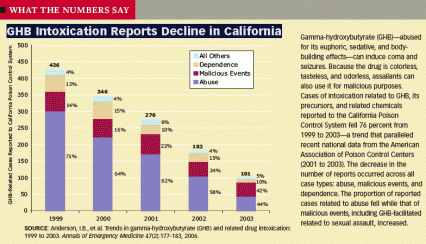 Gamma-hydroxybutyrate (GHB) - abused for its euphoric, sedative, and bodybuilding effects - can induce coma and seizures. Because the drug is colorless, tasteless, and odorless, assailants can also use it for malicious purposes. Cases of intoxication related to GHB, its precursors, and related chemicals reported to the California Poison Control System fell 76% from 1999 to 2002 - a trend that paralleled recent national data from the American Association of Poison Control Centers (2001 to 2003). The decrease in the number of reports occurred across all case types: abuse, malicious events, and dependence. The proportion of reported cases related to abuse fell while that of malicious events, including GHB-facilitated related to sexual assault, increased.
Gamma-hydroxybutyrate (GHB) - abused for its euphoric, sedative, and bodybuilding effects - can induce coma and seizures. Because the drug is colorless, tasteless, and odorless, assailants can also use it for malicious purposes. Cases of intoxication related to GHB, its precursors, and related chemicals reported to the California Poison Control System fell 76% from 1999 to 2002 - a trend that paralleled recent national data from the American Association of Poison Control Centers (2001 to 2003). The decrease in the number of reports occurred across all case types: abuse, malicious events, and dependence. The proportion of reported cases related to abuse fell while that of malicious events, including GHB-facilitated related to sexual assault, increased.Source
Anderson, I.B., et al. Trends in gamma-hydroxybutyrate (GHB) and related drug intoxication: 1999 to 2003. Annals of Emergency Medicine 47(2):177-183, 2006